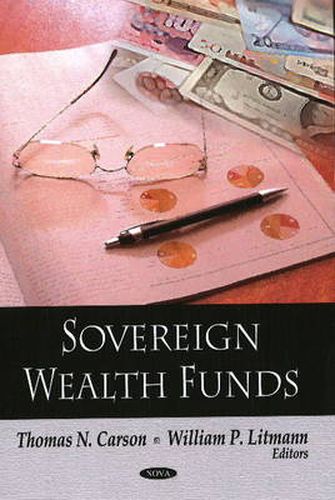Readings Newsletter
Become a Readings Member to make your shopping experience even easier.
Sign in or sign up for free!
You’re not far away from qualifying for FREE standard shipping within Australia
You’ve qualified for FREE standard shipping within Australia
The cart is loading…






Sovereign wealth funds (SWFs) are investment funds owned and managed by national governments. Such funds currently manage between $1.9 and $2.9 trillion and are expected to grow to over $12 trillion by 2015. This is due to the rapid growth of commodity prices and large trade surpluses in several emerging market economies. During the second half of 2007, interest in SWFs increased as Asian and Middle Eastern SWFs, fueled by surging foreign exchange reserves, invested large sums of capital in U.S. and other Western companies. Policy makers in the United States have raised two broad policy concerns about SWFs: (1) their lack of transparency and (2) their possible misuse for political or other non-commercial goals. Hearings have been held by several congressional committees including the House Financial Services Committee and the Senate Foreign Relations and Senate Banking Committees. Additional congressional hearings are expected in 2008. SWFs pose a complex challenge for policy makers. On one hand, SWFs are long-term investment vehicles looking beyond quarterly results and therefore serve as stable funding sources during financial turbulence. On the other hand, however, there are operational concerns stemming from government control (i.e., lack of transparency and possible non-commercial investment goals). Without transparency, it is difficult to attain a clear picture of SWF investment activity. A lack of SWF transparency can also obscure governance and risk-management problems within SWFs. Many are also concerned that countries will use SWFs to support what one analyst has called state capitalism, using government-controlled assets to secure stakes around the world in strategic areas such as telecommunications, energy and mineral resources, and financial services, among other sectors. In response to these concerns, many analysts and policy makers are evaluating the operations of existing SWFs and are looking to the international financial institutions such as the International Monetary Fund, World Bank, and the Organization for Economic Cooperation and Development to establish guidelines for SWF operations. All of these institutions are currently developing proposals that will be deliberated during 2008.
$9.00 standard shipping within Australia
FREE standard shipping within Australia for orders over $100.00
Express & International shipping calculated at checkout
Sovereign wealth funds (SWFs) are investment funds owned and managed by national governments. Such funds currently manage between $1.9 and $2.9 trillion and are expected to grow to over $12 trillion by 2015. This is due to the rapid growth of commodity prices and large trade surpluses in several emerging market economies. During the second half of 2007, interest in SWFs increased as Asian and Middle Eastern SWFs, fueled by surging foreign exchange reserves, invested large sums of capital in U.S. and other Western companies. Policy makers in the United States have raised two broad policy concerns about SWFs: (1) their lack of transparency and (2) their possible misuse for political or other non-commercial goals. Hearings have been held by several congressional committees including the House Financial Services Committee and the Senate Foreign Relations and Senate Banking Committees. Additional congressional hearings are expected in 2008. SWFs pose a complex challenge for policy makers. On one hand, SWFs are long-term investment vehicles looking beyond quarterly results and therefore serve as stable funding sources during financial turbulence. On the other hand, however, there are operational concerns stemming from government control (i.e., lack of transparency and possible non-commercial investment goals). Without transparency, it is difficult to attain a clear picture of SWF investment activity. A lack of SWF transparency can also obscure governance and risk-management problems within SWFs. Many are also concerned that countries will use SWFs to support what one analyst has called state capitalism, using government-controlled assets to secure stakes around the world in strategic areas such as telecommunications, energy and mineral resources, and financial services, among other sectors. In response to these concerns, many analysts and policy makers are evaluating the operations of existing SWFs and are looking to the international financial institutions such as the International Monetary Fund, World Bank, and the Organization for Economic Cooperation and Development to establish guidelines for SWF operations. All of these institutions are currently developing proposals that will be deliberated during 2008.